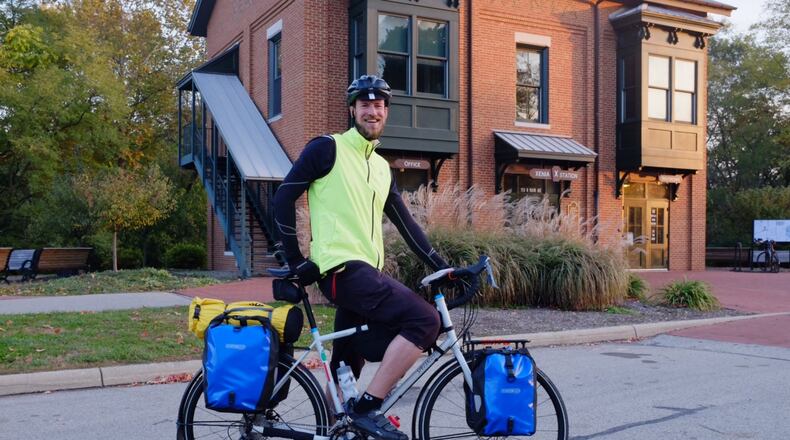Hart will share his love of bikepacking – also referred to as bicycle touring or bicycle camping – during the free upcoming Discover Bikepacking MetroParks programs in July and August. The hands-on programs will enable participants to check out equipment, try out a bike loaded with gear and learn about local resources and opportunities to get started bikepacking.
Bikepacking 101
What is bikepacking? Think backpacking on wheels – sort of. It’s not a hiker trying to navigate through the wilderness on a bike with a full-size backpack on his or her back.
“It’s lightweight bike touring, strapping things onto the bike, usually without racks,” Hart said. “You very quickly figure out what can be multi-purposed and you find a lot of lightweight gear.”
Hart speaks from experience as the Troy cyclist completed an adventure of a lifetime when he embarked on a 2,007–mile journey along the Underground Railroad Bicycle Route starting in Owen Sound, Ontario, and finishing in Mobile, Ala. He logged more than 70 miles a day – rain or shine – unpacking his sleeping bag and portable stove each night then packing it all up and setting off on another leg of the trip the next morning.
But bikepacking adventures don’t need to cross the country or even the state line.
“There are a lot of state parks in Southern Ohio that people like to go to,” Hart said. “And there are even great destinations closer to home.”
Several of the MetroParks offer campsites – Germantown and Twin Creek offer both frontcountry and more secluded backcountry sites, depending on how rustic you want your camping experience to be.
Bikepacking essentials
A good repair kit, first-aid essentials, a tent, supplies for cooking and water purification are just a few of the things that can be on the packing list. But there is something that Hart recommends long before the packing begins – planning.
“It’s always reassuring to know that you are prepared and have a plan,” he said.
That means planning a route in advance and having a good set of maps – traditional paper maps – with you.
Beginners and veteran bikepackers can benefit from the plentiful resources of the Adventure Cycling Route Network. The organization, established in 1973, features rural and low-traffic bicycling routes through some of the most scenic and historically significant terrain in North America. Since mapping its first route in 1976, the Adventure Cycling Route Network (www.adventurecycling.org) now includes an awe-inspiring 47,283-mile network. And the Bicycle Route Navigator app puts it all at your fingertips.
With bikepacking – much like backpacking – there is a bit of a learning curve when it comes to packing.
“After my first few trips, I easily cut 10 pounds off what I was carrying,” Hart said. “When I started, I was up in the 40s and now I’m in the 20-pound range.”
Reduced weight is only one of the benefits of minimizing the packing list.
“Parking down means more freedom and that’s one of the best parts of the whole thing,” Hart said.
Discover Bikepacking
What: Hands-on program to learn about bicycle camping
When: July 14, 11 a.m.-1 p.m.; Aug. 18, 11 a.m.-1 p.m.
Where: Huffman MetroPark, MoMBA, 4485 Union Rd.
Cost: Free and open to all ages
About the Author

